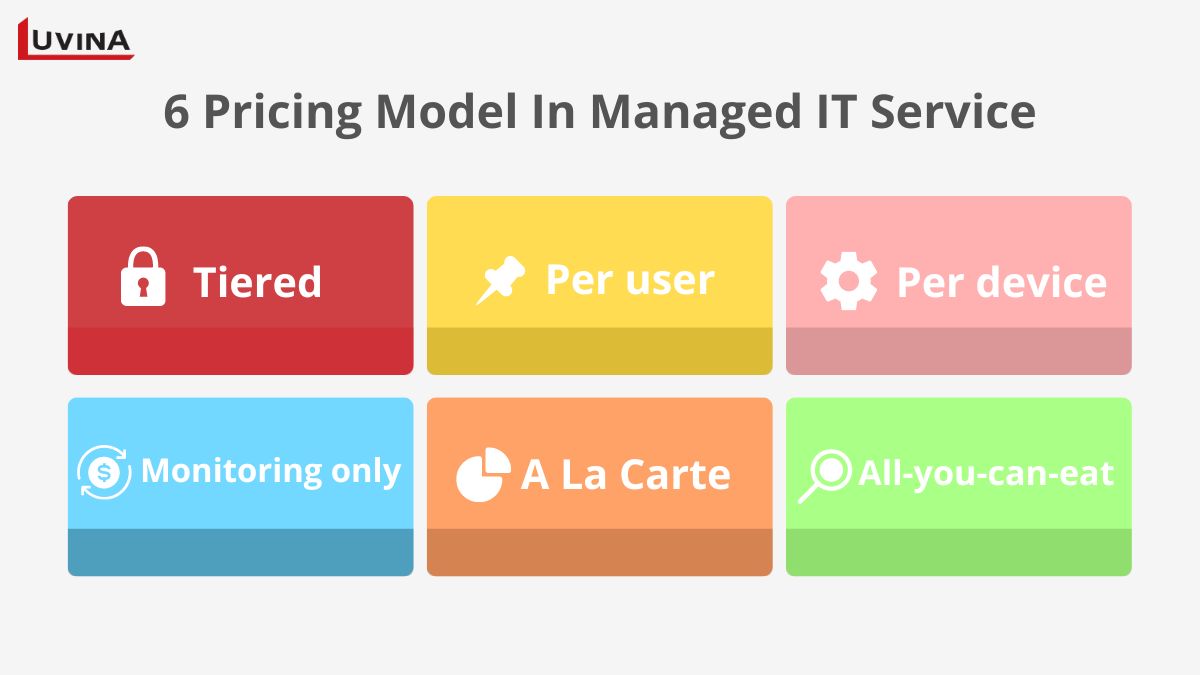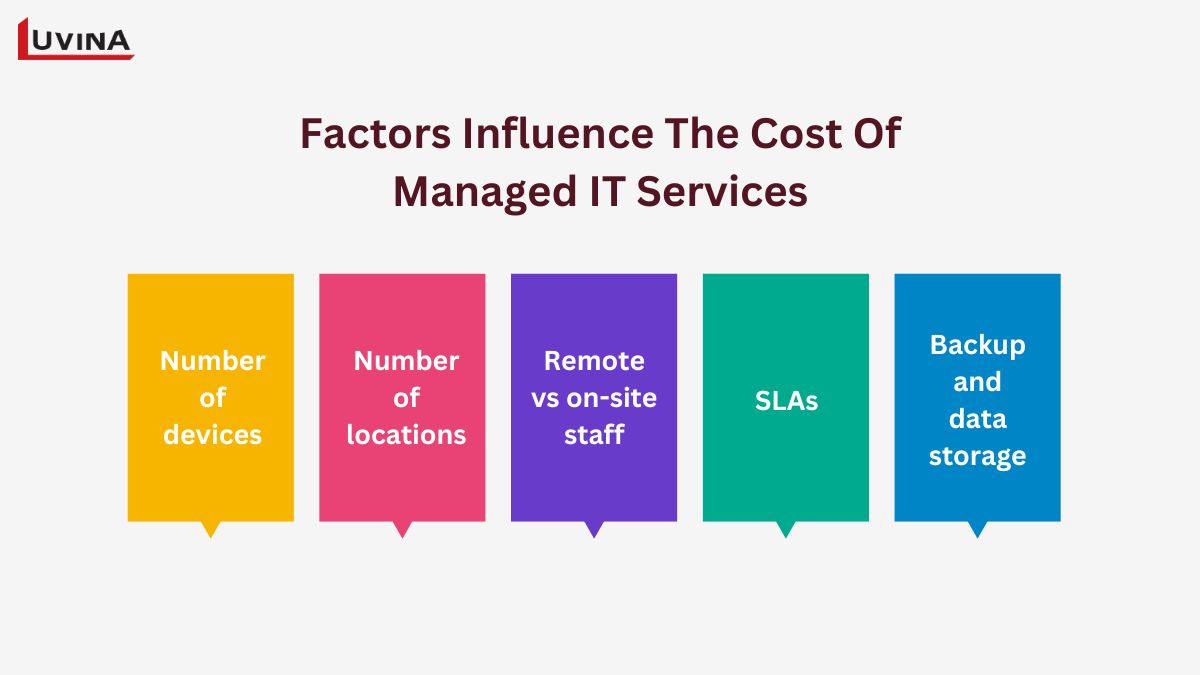Managed IT services costs are a common concern for many business owners. Pinning down an exact price for managed IT services can be challenging. However, there are several ways to estimate the cost. In the following article, we will explore the factors that affect the pricing of managed IT services, the pricing models, and average costs to help you estimate the cost of managed IT services for your organization.
Pricing Model in Managed IT Service
Most managed IT services today are charged through a subscription model. Businesses can pay hourly, annually, or monthly. However, managed IT services costs vary depending on the pricing model. Below are some common managed IT services pricing models.

1. Tiered
This is a bundled pricing model used by some service providers. With this model, providers offer businesses several predefined packages, such as standard, mid-level, and premium packages. Each package includes specific services. This managed services IT pricing model is beneficial for businesses because it allows them to easily predict monthly costs. However, businesses might end up paying for services they do not need if they choose a bundled package.
2. Per user
This is one of the most common models for managed IT services costs. With the per-user pricing model, businesses pay a fixed amount per user per month. Users here are not necessarily the number of employees but can be based on the number of end-users in the business’s IT infrastructure.
3. Per device
The per-device managed IT pricing model involves paying a fixed fee for each device connected to the managed network. If a business has many employees sharing devices, this model could be more cost-effective than the per-user model.
4. A La Carte
Similar to a restaurant menu, this pricing model allows businesses to select the services they want and only pay for those. This model can be cost-saving but may leave businesses uncertain about the services they truly need. If choosing this model of managed IT services cost, businesses should consult with the provider to select the appropriate services.
5. Monitoring only
This is a basic pricing model in IT managed services costs, where the provider monitors the business’s servers or network full-time to quickly detect any threats. This model is suitable for businesses with limited budgets or those with an in-house IT team. However, it can be risky as businesses might incur additional costs for fixing issues, potentially exceeding their IT budget.
6. All-you-can-eat
In this managed IT pricing model, businesses pay monthly or annually to access all available services from the provider. These services typically include on-site support, 24/7 helpdesk, security, device management, etc. This model offers stable costs and ensures timely support for any IT issues.
Factors that Influence the Cost of Managed IT Services
Managed IT services costs are influenced by various factors such as infrastructure complexity, number of users, and devices. Pricing varies depending on the level of service and expertise of the service team. Here are some factors that can affect IT managed services cost:

- Number of devices: The more devices you have, the more complex your infrastructure becomes. Managing, maintaining, and securing a complex infrastructure requires additional time and effort from service providers, thus impacting managed IT services cost.
- Number of locations: Small businesses operating from a single location generally incur lower IT-managed services costs compared to larger businesses with multiple offices spread across different locations.
- Remote vs. on-site staff: If you have a significant number of remote employees, your network complexity and security risks increase. This complexity requires more management effort from service providers, potentially raising costs.
- Service level agreements (SLAs): SLAs define the services you’ll receive and the corresponding costs. The more devices specified in the SLA for management, the higher the cost. Contract duration also affects IT management costs.
- Backup and data storage: The amount of data you need to back up and store impacts the hardware and support hours required. More data often translates to higher managed IT services costs.
Average Managed IT Service Cost
The average managed IT services cost varies depending on the pricing model chosen, the service provider, the type of managed service, and the complexity of your needs. The cheapest managed IT services typically include network and server monitoring, priced around $30 to $50 per user per month, or equivalently $75 to $275 per hour.
At this level, IT specialists monitor servers and networks, providing immediate alerts for you to handle issues yourself. However, these basic services may not be cost-effective in the long run as you might need to hire additional experts to resolve IT problems.
Moving up, mid-range managed IT services provide proactive issue resolution and may include 24/7 support, data backups, troubleshooting, network and device maintenance, and IT planning. Costs are fixed and vary:
- $100 to $400 per server
- $50 to $125 per workstation
- $30 to $75 per firewall
- $15 to $40 per switch
- $75 to $200 per user depending on specific services.
Lastly, premium managed IT service packages, often priced up to $300 per user per month, may include file storage, infrastructure hosting, and hardware-as-a-service.
For a clearer understanding of specific costs associated with each pricing model, refer to the table below:
| Managed IT services pricing model | Price range |
| Tiered | $3,000-$6,000/month |
| Per user | $175-$250/user/month |
| Per device | $200-$250/month/server$50-$100/month/individual device$25-$75/month/piece of networking equipment |
| À la Carte | $30-$100/user or device/ service/ per month |
Why Should Choose Luvina as the Managed IT Service Partner?
Businesses can be cautious when selecting Managed IT Service providers due to cost concerns. However, there are many providers in the market offering diverse service packages that fit each business’s needs and financial capabilities. If you are looking for a reliable provider with effective Managed IT services cost, consider Luvina.

With over 20 years of experience in IT outsourcing, Luvina serves businesses of all sizes with services including software development, system maintenance, operations, and on-site development. Our team of over 750 highly skilled IT experts is proficient in English and Japanese and available 24/7. We are committed to delivering top-quality service certified to ISO 9001 and CMMI Level 3.
Luvina’s Managed IT Service uses a combination of pricing models based on SLA agreements in service contracts, ensuring comprehensive service coverage tailored to meet clients’ needs and budget constraints. Contact Luvina today for a consultation.
>> Also read: 15 Managed IT Services Companies
Conclusion
We understand that cost is a crucial factor that businesses consider when discussing Managed IT Services. Through this article, we hope you now have a clearer understanding of the managed IT services cost structure and the pricing models available to choose from. This knowledge will help you select a suitable service package and formulate an effective budget plan.









Read More From Us?
Sign up for our newsletter
Read More From Us?
Sign up for our newsletter